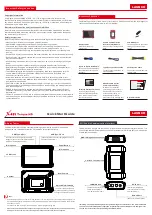
RTC
®
5 PC Interface Board
Rev. 1.9 e
8 Advanced Functions for Scan Head and Laser Control
184
innovators for industry
8.7.4 Compensation of 2D Motions
You can use the
command to activate
encoder-based 2D Processing-on-the-fly correction
(e.g. for XY stages), particularly for continuous
marking in the virtual image field. Unlike activation
via
advantages:
•
simultaneously resets both encoders
(whereas the separate commands
and
do so with a slight temporal offset
between both channels)
•
allows compensation of non-linear
relations between encoder values and actual XY
stage motions (see the
Compensation for XY Stages" on page 184
).
•
allows using coordinate transforma-
tions within the virtual image field (see the
section "Coordinate Transformations in the
Virtual Image Field" on page 185
• Even during an interruption of a
marking via
, the galvanometer
scanner positions receive continuous Processing-
on-the-fly correction in accordance with the
current XY-stage encoder values (whereby the
laser focus remains stationary relative to the XY
stage). Thus, unnecessary jumps are avoided after
XY stage motions (see
).
Notes
• You
can’t
combine
correction with
other Processing-on-the-fly corrections (see the
section "Overview" on page 178
).
2D Encoder Compensation for XY Stages
For particularly demanding marking requirements, it
might be necessary to also compensate an XY trans-
lation stage’s mechanical deviations. Here, you can
use the
command to load a 2D
compensation table onto the RTC
®
5 (see below).
Then – during a Processing-on-the-fly application
initiated via
– encoder values will be two-
dimensionally interpolated and compensated just like
with field correction tables.
To avoid unnecessary initialization motions, you can
use the
command to define a desired
translation stage start position as the reference value
for 2D encoder compensation (and to store it on the
RTC
®
5 board). Upon every subsequent encoder reset
, the current position will be automat-
ically applied as the new reference position, so that
the relation between current encoder values and the
stage’s absolute position is retained for compen-
sation. This relation remains even upon termination
with
,
but not if you meanwhile activate other Processing-
on-the-fly corrections or reset the encoders via an
external /START (see
, bit # 9 = 1).
At any time, you can query the currently valid
reference values via
Encoder compensation is applied exclusively to
Processing-on-the-fly correction. The commands
and
, as
well as
and
use the original
uncompensated encoder values. The same applies to
recording via
(
Signal
= 43 or 44) and
command, you need to
provide an ASCII text file that contains a compen-
sation table. This table must have encoder compen-
sations for reference points on a rectangular grid. The
number of grid lines and their spacing is up to you
(both may also differ in X and Y). Missing reference
point data will be automatically assigned a compen-
sation of 0. The largest occurring encoder reference
points form a frame within which encoder compen-
sation values will be bilinearly interpolated. Encoder
values outside this frame will be clipped to this frame
prior to interpolation. Therefore, the reference points
should cover at least the range of the XY stage
required by your application. Reference points with
values exceeding ±524288 can result in some loss of
precision.
















































